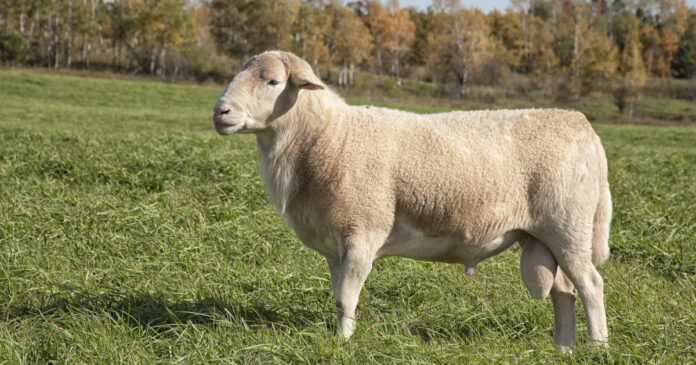Last Updated on November 12, 2023 by Fumipets
Katahdin Sheep
A domestic breed of sheep named after Mount Katahdin, Maine’s highest peak, was created in Maine in the United States. The breed was created in the middle of the 1950s by mating Suffolk Sheep with imported St. Croix Sheep and other breeds.
Due of expensive shearing expenses and poor wool sales, they are kept mostly as meat animals in the U.S. and have seen tremendous growth in popularity in recent years. The Katahdin Sheep are distinctive in that they have hair, not wool, and spontaneously shed their winter coats, requiring far less upkeep than woolen sheep types.
Continue reading for more information on the Katahdin Sheep if you think it could be the breed for you.
Quick Facts About Katahdin Sheep
| Species Name: | Ovis aries |
| Family: | Bovidae |
| Care Level: | Moderate |
| Temperament: | Hardy, adaptable, docile |
| Color Form: | Most commonly white, but also black, brown, and red |
| Lifespan: | 10-12 years |
| Size: | Medium-sized, 140-185 pounds |
| Diet: | Herbivorous |
| Minimum Enclosure Size: | 16-20 square feet indoors, about 6 sheep per acre outdoors |
| Compatibility: | Friendly, docile, and easy going |
Katahdin Sheep Overview
Medium to big sheep called katahdins are very versatile, resilient, and low-maintenance creatures that are a fantastic place to start for beginning sheep producers. They can withstand a variety of temperatures and were produced from varieties that originated in both the Caribbean and Britain. They develop thick coats in the winter to remain warm, which they subsequently shed in the summer. They are also very resistant to both internal and external parasites, and with proper care, they only need minor parasite treatment. They are wonderful creatures to keep on a small property since they are gentle, pleasant, and manageable animals.

How Much Do Katahdin Sheep Cost?
A Katahdin lamb will normally cost between $300 and $600, depending on supply and demand. They are simple to find and have quickly risen to the top of the most popular breeds in the country. Since these sheep are often crossbred, check to see whether the breeder you buy them from has all the required documentation to certify that they are purebred. It might be difficult to distinguish between crossbred and purebred lambs.
Typical Behavior & Temperament
When grown correctly, Katahdin sheep have minimal fear of people, definitely less than other sheep breeds, and are pleased to be touched since they are such gentle and sociable creatures. They do prefer living in flocks, although they only do so sometimes. If they feel comfortable, they may be spotted wandering out by themselves. Mothers have a strong maternal instinct that makes them exceptionally caring and protective. You will only ever see a Katahdin behaving violently in this situation.
Appearance
Although Katahdin Sheep are most often white, they may also be seen in almost every color combination, including solid or varied shades of brown, black, and red. Since they are hair sheep, they don’t need yearly shearing like other sheep breeds do. In the summer, they just lose their coats on their own.
As medium-sized sheep, katahdins normally weigh between 125 and 185 pounds for females and 180 to 250 pounds for males.
How to Take Care of Katahdin Sheep
Shelter
Although resilient and able to withstand both cold and heat, Katahdin sheep nevertheless need a suitable shelter for resting, safety from predators, and most importantly, for lambing. The ideal shelter would be constructed of wood with a latchable door to keep them inside during the night, inclement weather, or to keep other sheep out when moms are lambing. It is essential to provide soft bedding, such as hay, and to replace it often. For warmer regions, the shelter should also be adequately ventilated; but, unless you live in an exceptionally cold area, insulation shouldn’t be a major concern.
Enclosure
A sheep-proof fence is necessary to keep your Katahdin where you want them to stay. This protects them from possible predators while also keeping them contained in an area where you want them to graze. The cheapest and most straightforward choice is woven wire, which is also simple to install and relocate if required. Due to the docile character of Katahdin sheep, electric fence is fantastic but expensive to install initially. However, electric fence can be your best option if you have a serious problem with huge predators.

Do Katahdin Sheep Get Along With Other Pets?
In general, Katahdin sheep get along brilliantly with other animals and pets since they are amiable, non-aggressive creatures. Although many farmers advise against keeping several sheep types together, this is more because of their diverse demands and the expenses involved than it is because of their disposition. Another indication of these sheep’s flexibility and good nature toward other sheep breeds is the fact that they are often utilized for crossbreeding. Only male sheep during mating season or when moms have small lambs may display hostility against other sheep due to their strong protective instincts.
What to Feed Your Katahdin Sheep
One Katahdin The majority of a sheep’s diet consists of grazing on pasture or, throughout the winter, high-quality hay. Because it is the most diversified diet, pasture is the healthiest for them. In addition to different types of grass, it often includes weeds, clovers, and flowers, all of which provide them with essential nutrients. Occasionally, you may need to add more hay to their pasture-based diet and supplement it with additional nutrients.
Keeping Your Katahdin Sheep Healthy
Because of their diverse genetic makeup, Katahdin sheep are typically a robust, healthy breed with minimal health problems. Due to this, they have a high level of resistance to internal and external parasites. Because they don’t need routine shearing and spontaneously lose their coats, they are among the simplest sheep breeds to take care of. Your Katahdin will probably live a long, healthy life if they eat a balanced diet and have lots of room to explore.
Breeding
Ewes and rams develop quickly and enjoy long, fruitful lives. At roughly 10 to 12 months of age, mothers are usually ready to reproduce and will often give birth to twins, perhaps triplets. The ewes are powerful, protective, and loving moms that readily give birth without help; mothers rejecting their babies are uncommon. The rams are active breeders and are often fertile throughout the year.
Katahdin It is standard practice to crossbreed sheep, which is simple to do. Their first generation of progeny generally has a thick wool coat with scattered hair when they are bred with wool sheep. To create children with a shedding hair coat, breeding normally requires three generations.
Are Katahdin Sheep Suitable for You?
Katahdin Sheep are often simpler to care for than other sheep breeds since they don’t need yearly shearing because they don’t have wool coats. Along with being docile, amiable, and extremely resistant to parasites, this makes them an excellent option for novice livestock managers. The Katahdin Sheep are wonderful complements to any small farm because of their amiable disposition, minimal maintenance requirements, resilience to parasites, and moderate size.


















